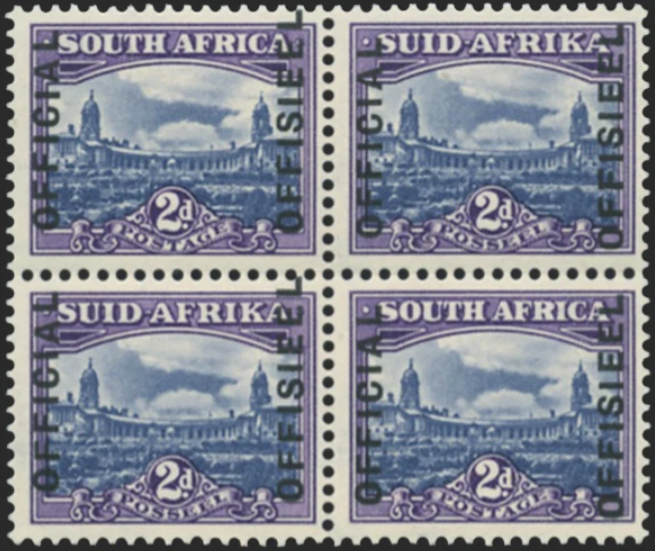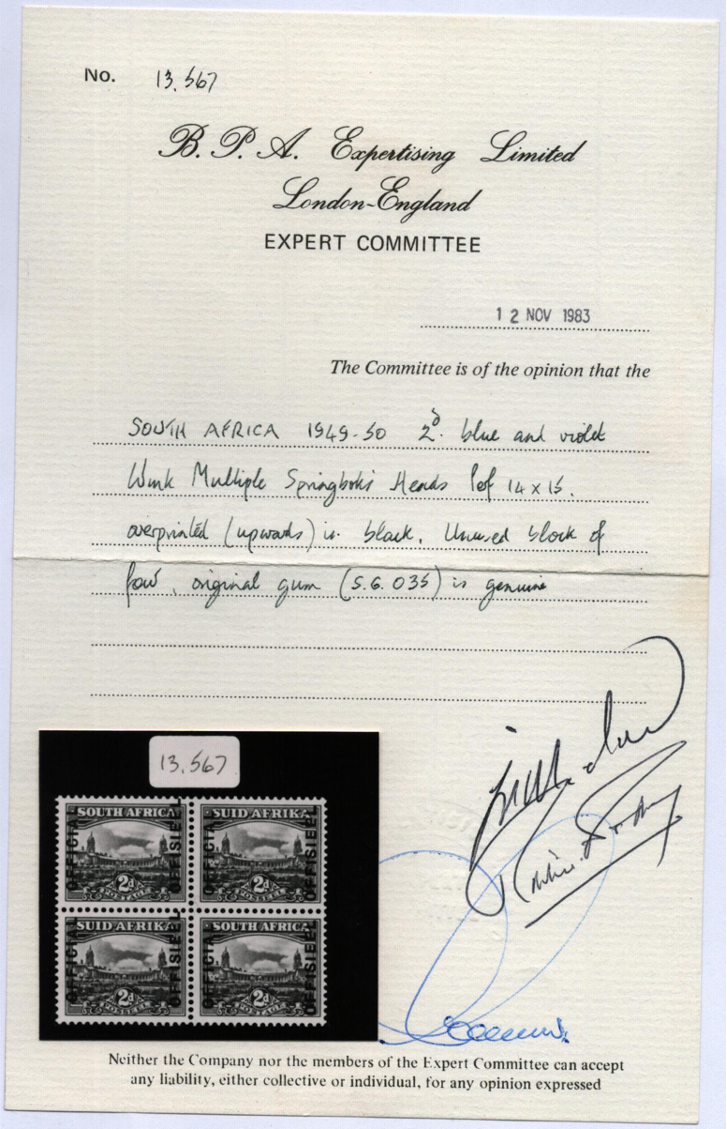The hottest rarity from the hottest area of the stamp market
The stamps of South Africa have always been popular with collectors.
Wonderful designs and a fascinating complex postal history make them a great area to collect.
The African stamp market, in general, is one of the hottest areas of the market just now. The level of demand is evident from higher auction realisations and rising catalogue values.
This area of the market has outpaced most other areas in terms of momentum in the past 3 to 5 years.
The Government Official stamps, in particular, are very rare as they were originally not available for sale to the public.
These stamps were used exclusively by Government departments.
It is a popular area of collecting because of the layers of complexity to uncover, providing a lifetime of fascinating philatelic study.
Because this area of philately has attracted such dedicated study, it benefits from generations of expert research.
The most exceptional example of the most famous rarity
We are excited to have secured for you what is the greatest rarity from this popular area of philately.
It is such an exciting find because…
- It is an extremely rare printing error which attracted huge philatelic debate, leading to it entering the philatelic hall of fame
- It is remarkable in that it remained undiscovered for over thirty years
- It is considered the most aspirational South African government official philatelic rarity you could possibly own
- It is the hardest space to fill in the King George VI stamp album
- Normally only seen in pairs. We have the only block of four we have ever seen.
- It is in the finest possible condition, being unmounted mint with full original gum
Here is the central showpiece every collector in this area of collecting would love to own…

Technical description:
South Africa 1944-50 Official 'Set 23' (= 1949-50 issue) small format 2d blue and violet, SG type O6 overprint (reading upwards with 'OFFICIAL' at left and 16mm between lines of overprint), BLOCK OF 4, SGO35.
Exceptional quality multiple of this key King George VI rarity, unmounted mint with full original gum.
The error on this Government Official stamp is made more famous because of the early philatelic debate surrounding whether it was legitimately issued in error. It was ultimately, after much academic study, accepted as being legitimately issued in error and has now achieved philatelic fame.
Accompanied with a British Philatelic Association (BPA) Certificate of Authenticity (1983).
The Stanley Gibbons catalogue value is £8,500+.
Price: £7,950
The Official Government stamps of South Africa
In 1926, the first stamps were issued for the sole use by the government departments of South Africa.
They remained in production and issue until 1955.
They were an interesting peculiarity at the time because they were issued in bi-lingual pairs with the overprint “OFFICIAL/OFFISIEEL”.
This was done to appease the Afrikaans and Colonial sensitivities at the time.
What makes these stamps so fascinating to collectors is the method of production for the overprints.
They were applied by letterpress (typography). The plates were never set and were manufactured using the “Linotype” process. In this process, an operator typed the overprint on a keyboard. The machine then produced whole words by hot metal casting.
After this, they were assembled manually into a printing plate giving a likelihood of variations in spacing between the words.
Because of the manual process involved, collectors have identified an abundance of printing varieties and errors over the years. This has led to it becoming an absorbing area of study.
The most famous printing error of them all
The South Africa 1944-50 2d Official with the overprint reading up is the most famous of all these printing errors.
It took many years before the existence of mint examples were accepted by philatelic experts.
The South African Philatelist first reported in 1952 that this error exists in used condition, but no sufficient understanding of its origin is known.
Used examples first turned up on mail addressed to England.
Following enquiries into their origin, it was learned that several sheets of the small 2d stamps had been overprinted for official use from the old forme instead of from the new stereotype process blocks.
They had subsequently been used up by one of the Government departments in Pretoria in the normal course of official business.
No mint examples were, however, known to exist.
During 1984, Alan Leverton of Bridger & Kay informed that a full sheet of mint examples was jointly purchased by his Company and Stanley Gibbons.
The existence of this mint sheet was initially disregarded by the doyens of Union philately. The attitude at the time was that unless these stamps resided in South Africa, they must be fake.
This made no sense as London had always been the stamp capital of the world and paid better prices for rarities than any other country.
Furthermore, it was illogical to accept the existence of used examples, without the possibility of mint examples.
Mint sheets had to be printed before they could be used for postage. In all likelihood, a few extra sheets were printed at a later stage.
Only one mint sheet has ever been identified. Today, mint examples from that sheet always fetch high prices when they come to auction.
Clear Provenance
The original source of our block of four is clear as it came from the only known sheet purchased by Bridger & Kay and Stanley Gibbons in 1984.
The British Philatelic Association (BPA) also supports its authenticity with their certificate from 1983…

A Warren Buffett Stamp Investment
I always look for Warren Buffett style value investments in rare stamps.
This occurs where it is evident catalogue values are below intrinsic values.
There are always certain rarities where the market value is behind fair value, signalling a higher potential for a future hike in prices.
The history of pricing in the Stanley Gibbons catalogue of the 1944-1950 2d Official with the overprint reading up makes for interesting reading…

Overall growth in value in the past 20 years of 150% (average 7.5% simple growth pa) is a reasonable rate of price appreciation.
There is a clear anomaly, however, in the absence of any growth in value over the past five years.
I would think the next Stanley Gibbons catalogue, when it is published later this year, should show a price increase.
The current value for such an iconic rarity is well below most of its peers.
We know that Stanley Gibbons catalogue values often lag behind true market values.
Looking at recent auction realisations, unmounted mint examples of South African Official varieties and errors can sell at multiples of catalogue values.
I have witnessed varieties estimated to sell for £350 to £400 realising £1,600 (4 times the upper estimate).
On the flipside, examples with condition defects continue to sell for much less than catalogue values.
This is why our unmounted mint example of the greatest rarity in this area of the market is the most desirable.
The finest quality at a fair price
I would always rather pay more for the finest quality rather than less for poorer quality.
That said, the aim is always to provide you the best quality at a price below fair value. This gives you a margin of safety in your purchase.
In this case, I have achieved this goal for you.
The Stanley Gibbons catalogue value for this major South African rarity is £4,250 for a pair.
Our block of four would therefore have a minimum catalogue value of £8,500.
A premium would also be expected based on the added rarity factor of a block of four compared to a pair.
You can own this premier South African rarity today for the price of £7,950.
Strong yet under-valued area of the market
South African Official varieties and errors should, in theory, represent a sound area of the stamp market for investment. They have all the qualities needed to perform…
Limited Supply: they are very rare, particularly in fine condition, not least because, originally, they were not available for sale to the public.
Strong Demand: they provide a huge area of fascinating study, which has attracted a large and keen base of collectors.
Momentum: the African stamp market is one of the hottest areas of the market with auction realisations and prices rising more than most other areas of the market in the past five years.
Owning the recognised greatest rarity from this area of the market is the ultimate prize.
Or email me today at mike@paulfrasercollectibles.com.
I will e-mail you back straight away to let you know if it is OFFICIALLY yours.
Thanks for reading.
Kind regards
Mike Hall
P.S. It is also interesting to note the Stanley Gibbons catalogue lists a higher value for used pairs of the 1944-1950 2d Official with the overprint reading up at £6,000 compared to £4,250 for mint examples.






